As spring breakers descend on Florida beaches, great white sharks pop up along coast
Traveling to Florida for spring break to enjoy the warm, crystal-blue waters and amazing food options?
So are North Atlantic great white sharks.
When the waters around Canada and New England get too cold and food sources become scarce, great white sharks head south for the winter and begin to pop up all around the Sunshine State, including the Gulf of Mexico.
They tend to mostly hang out away from beaches in continental shelf waters, according to research group OCEARCH chief scientist Dr. Bob Hueter, but a 2021 Atlantic White Shark Conservancy study found white sharks off Cape Cod spent almost half of their time at depths of 15 feet or less.
Still, the chances of being bitten by a shark are low – one in 3.7 million, according to the International Shark Attack File (ISAF) – compared to "other animal encounters, natural disasters and ocean-side dangers." ISAF reported 69 unprovoked shark attacks worldwide for 2023, with most bites attributed to mistaken identity.
The U.S. led the world with 36 attacks, and Florida was the state with the most bites at 16.
OCEARCH, a nonprofit group researching the ocean's giants, has tagged more than 90 great white sharks in the western North Atlantic. Scientists track the sharks via satellite tags attached to their dorsal fins. When a tag breaks the surface of the water, a ping with location information is sent to trackers.
Between Feb. 1 and March 6, eight great white sharks have pinged in Florida waters, including two in the past few days.
Here's what we know about great white sharks around Florida and how to reduce the risk of being bitten.
10-foot great white shark Rose pings off Sarasota, then Cape Coral, Florida, in 2 days
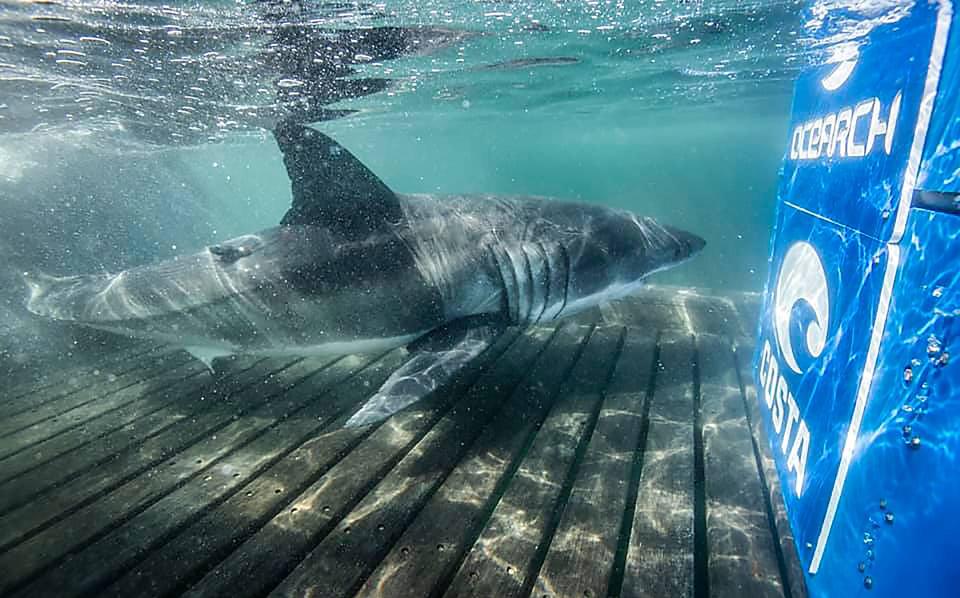
Female white shark Rose, a 10-foot-5-inch, 600-pound juvenile when she was tagged by OCEARCH in 2020, pinged off the Sarasota coast on March 5 after surfacing around Cape Coral on March 3.
Rose also pinged off Florida's Treasure Coast, near Stuart on Feb. 17 and 18, and Boynton Beach Feb. 19. The shark's tracker shows it has spent winters around Florida since 2021.
Rose previously ventured into the Gulf of Mexico in 2022 and 2023 and in March 2022 swam as far as the Panhandle, near Panama City.
9-foot white shark Keji surfaces off Panama City coast in Gulf of Mexico
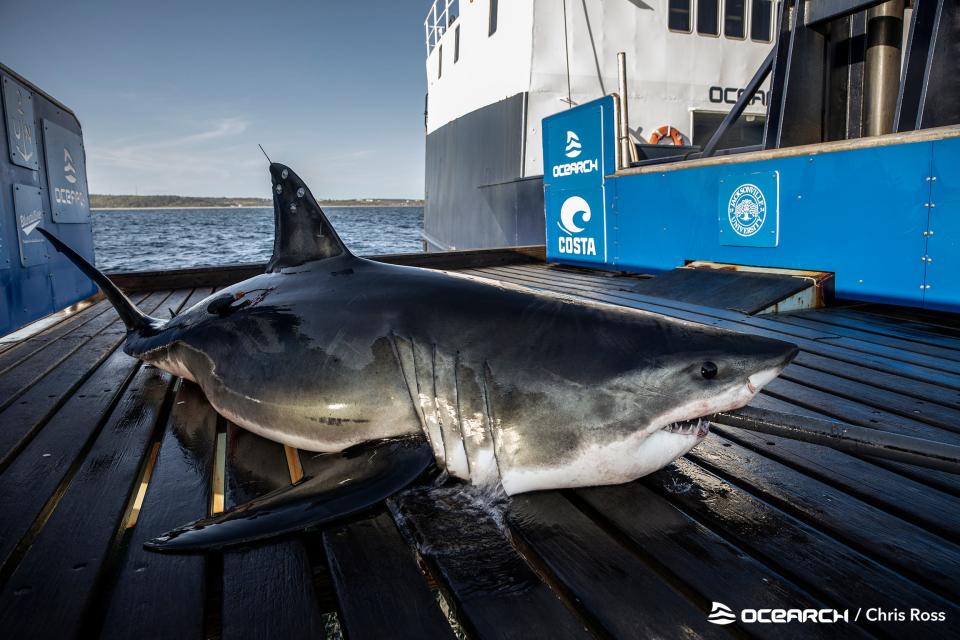
Keji measured 9 feet 7 inches, weighed 578 pounds and was classified a juvenile when OCEARCH scientists tagged it off Nova Scotia in 2021.
The shark's been hanging around the Sunshine State since November, pinging southeast of St. Augustine on Nov. 30, 2023, near the Florida Keys on Dec. 13, 2023, off Marco Island in 2024 on Feb. 4 and Feb. 16 and in the waters off the Panama City coast on March 4.
Colossal 1,700-pound great white shark Mahone tracked off St. Augustine Beach, Florida, on Leap Day 2024
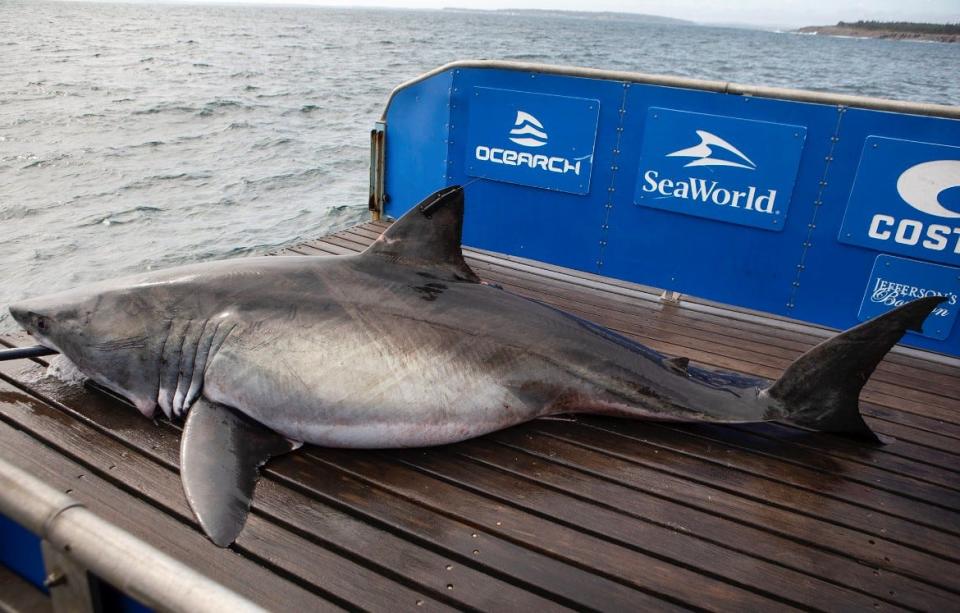
Great white shark Mahone, a mature adult male, measured an eye-popping 13 feet, 7 inches long and weighed 1,701 pounds when it was tagged off Lunenburg, Nova Scotia in October 2020.
Mahone pinged off St. Augustine Beach on Leap Day – Feb. 29. Its previous trip to Florida was as far south as the Canaveral National Seashore in March 2022.
Mahone is the largest white shark OCEARCH has tagged in Canadian waters.
Another huge white shark pinged along Florida's east coast on Leap Day 2024.
Massive 13-foot white shark Bob surfaces near Palm Coast, Florida, on Feb. 29 or Leap Day 2024
OCEARCH tagged 13-foot 4-inch, 1,308-pound great white shark Bob in Nova Scotia in 2021.
Bob pinged off Palm Coast on Leap Day after previously being tracked in Jacksonville waters on Jan. 31.
The shark has wintered in Florida before, swimming as far south as St. Augustine in November 2021 and Flagler Beach in 2022.
3 great white sharks ping around Florida Keys in February 2024, including 1,600-pound male
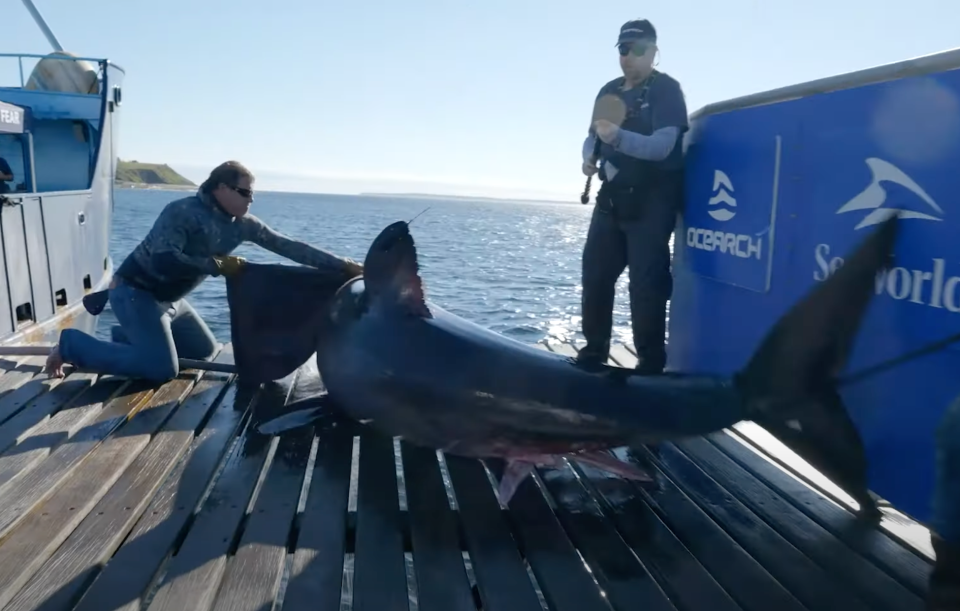
A 12-foot, 3-inch, 1,644-pound white shark named Scot pinged in the Florida Keys on Feb. 10 and Feb. 28. Scot's previous Florida trips took him into the Gulf near Sarasota in March of 2022, but it hung out around the Keys April through June 2023.
Scot was tagged by OCEARCH scientists off Nova Scotia in September 2021.
Penny, a 10-foot 3-inch, 522-pound female white shark was tagged in April 2023 off North Carolina. Its latest ping was Feb. 8 near Scot's location in the Keys. The shark previously pinged in the Gulf of Mexico, near Marco Island on Jan. 6 and Jan. 20 and Cape Coral on Jan. 15.
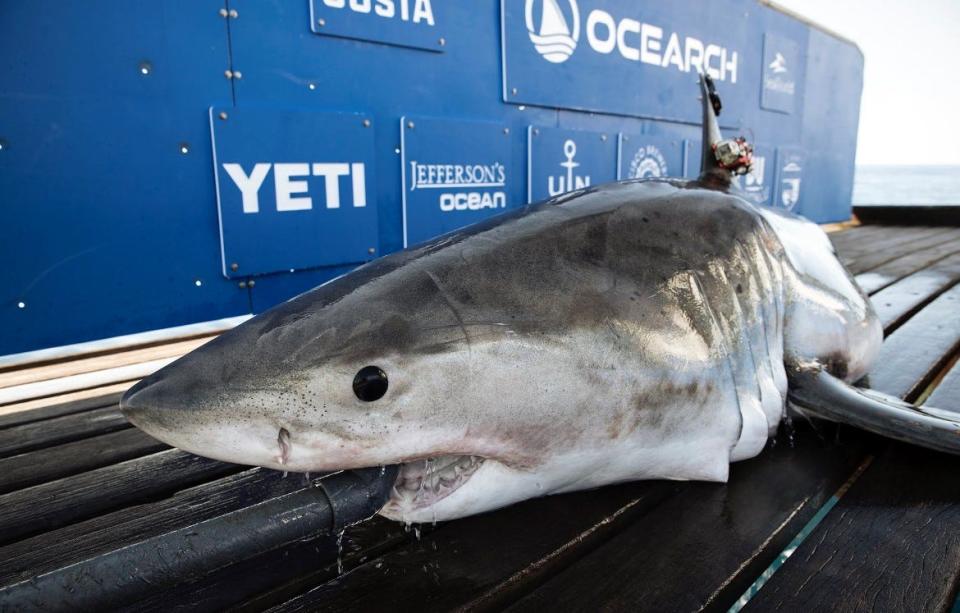
An 8-foot, 8-inch juvenile white shark named Jekyll west of the Keys on Feb. 15. Jekyll also pinged off Jacksonville Feb. 4 and near Jupiter Island on Feb. 7
Jekyll surprised scientists when they discovered the shark traveled for 4,000 miles alongside a 9-foot white shark named Simon. White sharks were previously thought to prefer only solitude.
But they may have parted ways. Their trackers showed them long distances apart in January and early February.
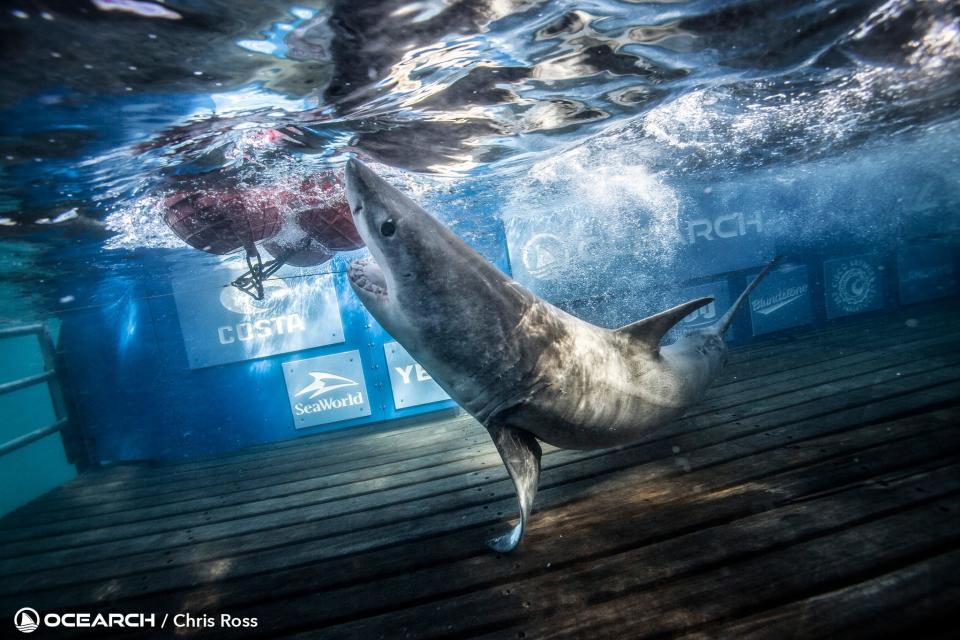
Simon the shark surfaces in Gulf of Mexico, around Southwest Florida
Jekyll's "buddy" Simon, a 9-foot, 6-inch juvenile white shark, was tagged by OCEARCH in December 2022 off the Georgia coast.
Simon pinged off Vero Beach on Jan. 17, near Stuart Jan. 20 and on Feb. 4. far off Marco Island.
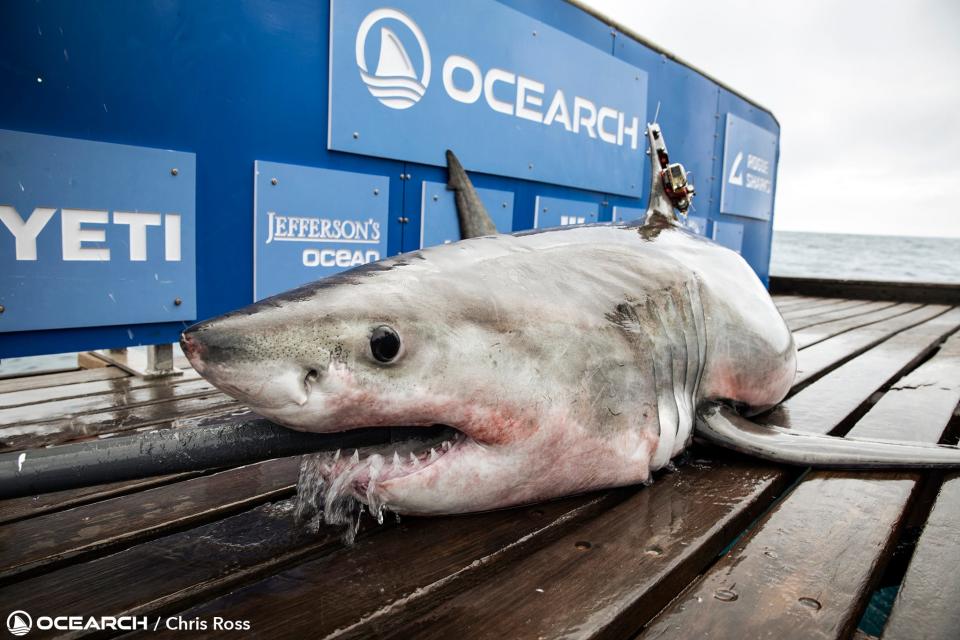
How to reduce your risk of a shark attack
While the chances are slim, shark bites and attacks can happen. There are things you can do to reduce the risk:
Don't go into the water alone.
Don't go too far from shore. Being far away from the shore means it could take too long for emergency assistance to reach you.
Avoid swimming at dawn or at dusk. Sharks are most active at those times and the risk of a shark mistaking you for other prey increases when the light is low.
Don't go into the water where people are fishing.
Be cautious in areas between sandbars and near dropoffs.
Don't wear high-contrast clothing. Sharks see contrast very well.
Take off shiny jewelry. It can shimmer and look like fish that sharks prey upon.
Try not to splash. Sharks may mistake the noise for a struggling fish.
Don't go into the water if sharks are known to be present and get out if sharks are seen.
If you are bleeding, stay out of the water.
The presence of dolphins means there are no sharks: Fact or myth?
A dolphin's presence does not mean there are no sharks nearby. Both eat the same food items, meaning both can be present.
"If anything, it's the opposite," Stephen Kajiura, a shark expert at Florida Atlantic University, told Live Science, "If you see dolphins, more often than not, there might be sharks in that same area."
Florida shark attacks by county
The U.S. led the world with 36 unprovoked shark attacks in 2023. Florida had most bites at 16, with Volusia County leading the way.
Miami-Dade County: 1
Pinellas County: 1
Support local journalism by subscribing to a Florida news organization.
This article originally appeared on Fort Myers News-Press: Sharks in Florida: Recent great white shark 'visits' and safety tips

